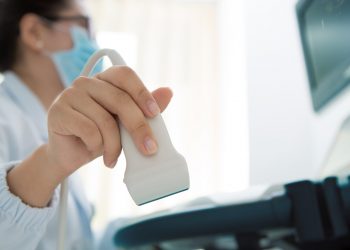
In this blog, NYC pulmonologist, Dr. Marc Bowen, provides answers about thoracic ultrasounds.
What is a thoracic ultrasound?
A thoracic ultrasound is a non-evasive test that allows your doctor to view images of the inside of your chest. He or she can examine structures and organs including your lungs, heart, esophagus, and lymph nodes while also seeing the blood flow to these areas.
This type of procedure is non-invasive and completely painless. It involves using a transducer (a special wand) on your skin to send out high-frequency ultrasound waves to the organs and structures of your chest. The waves bounce back to the transponder, relaying information that’s converted into an image on a screen. Your doctor can view the image as the test is being performed and record it for later consultation.
Why is a thoracic ultrasound performed?
This procedure may be performed for a variety of reasons, including the following:
- To check for the presence of excess fluid in the chest and determine its type and cause
- To evaluate the heart and its valves
- In conjunction with a biopsy or a procedure to remove fluids from the chest area
- To check the movement of your diaphragm
- To further investigate symptoms of pneumonia
- To check for evidence of a collapsed lung
Symptoms that include shortness of breath, a chronic cough, or a tightness or pain in your chest may prompt your doctor to recommend a thoracic ultrasound.
What are the advantages of a thoracic ultrasound?
It’s non-invasive and painless and can be conveniently and quickly performed in your doctor’s office. It allows your doctor to immediately view the results of your test and thus pinpoint any issues quickly and begin to prescribe any needed treatment.
It’s a safe procedure – in fact, you’re probably most familiar with ultrasounds being performed on pregnant women to examine their fetuses as well as blood flow to the baby.
In addition, preparing for an ultrasound generally doesn’t require any fasting or other special preparation, and you won’t have to be sedated during your ultrasound. However, if you’re having another procedure performed at the same time, this may change.
What can you expect after undergoing a thoracic ultrasound?
Based on the results of your ultrasound, your doctor will be able to quickly diagnose whether you have a condition such as pneumonia, excess water in the lungs, fluid in the lungs, or a collapsed lung.
Often this diagnosis can be made within minutes, enabling you to avoid lengthy wait times to get your results and begin treatment. The sooner an accurate diagnosis can be made, the better, because your doctor can explain your treatment options and quickly get started on helping you breathe easier.
Where can I have a thoracic ultrasound performed in NYC?
Dr. Marc Bowen provides the highest quality of patient-centered care. He has nearly 30 years of experience in treating pulmonary disease and in critical care medicine and internal medicine.
Dr. Bowen and his practice make each experience as comfortable and easily accessible as possible, offering same-day appointments and a convenient online patient portal. He also offers the latest diagnostic tests and in-office procedures – including thoracic ultrasound – to aid him in providing the highest level of care. And if you require hospitalization, Dr. Bowen can continue your continuity of care through his active affiliations with hospitals such as Lenox Hill Hospital, New York Methodist Hospital, and NYU Lutheran Medical Center.
If you’re experiencing symptoms such as a chronic cough, shortness of breath, a chronic cough, or a tightness or pain in your chest, contact MXBowen, Physician P.C., Health & Breathing Center today to get the answers and treatment you need.

